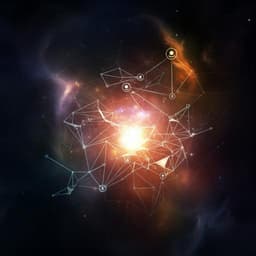
Physics
Experimental observation of chimera states in spiking neural networks based on degenerate optical parametric oscillators
T. Makinwa, K. Inaba, et al.
This research reveals the fascinating dynamics of chimera states in networks of identical photonic spiking neurons using coupled degenerate optical parametric oscillators. Conducted by Tumi Makinwa and colleagues, this study uncovers how synchronization leads to unexpected spiking frequency shifts, showcasing both Class-I and Class-II spiking dynamics.
~3 min • Beginner • English
Introduction
Chimera states—coexistence of synchronized and desynchronized dynamics among identical coupled oscillators—are a central topic in nonlinear dynamics. Although originally thought to require stringent conditions (e.g., nonlocal interactions in Kuramoto-type models), later studies showed chimeras occur under broader coupling topologies, including local and global interactions. Spiking neural network (SNN) models (FitzHugh–Nagumo, Hindmarsh–Rose, Morris–Lecar, Wilson–Cowan, etc.) have been widely used to investigate such phenomena, and adaptive coupling has been proposed to stabilize chimeras. Despite extensive theory and experiments in oscillatory and optical systems, experimental demonstrations in SNN-like platforms remained scarce. This study addresses that gap by experimentally realizing chimera states in a photonic SNN built from paired degenerate optical parametric oscillators (DOPOs), capable of exhibiting Hodgkin Class-I and Class-II spiking. The work explores how synchronization can induce spontaneous spiking-mode shifts and how these shifts facilitate and stabilize chimeras, including moving and turbulent types.
Literature Review
Prior work established chimera states in nonlocally coupled phase oscillators and broadened the definition to include amplitude chimeras, with classification schemes applicable to both simple oscillators and SNNs. Subsequent SNN-focused research demonstrated chimeras under local, global, and adaptive couplings, and in various neuron models (FitzHugh–Nagumo, Hindmarsh–Rose, Morris–Lecar, Hodgkin–Huxley extensions). Experimental observations of chimera-like behavior have been reported across diverse real-world and laboratory systems (power grids, condensed matter, biological rhythms, lasers), yet experimental SNN-like realizations (e.g., electronic mimics) were limited. Theoretical suggestions that adaptive mechanisms can stabilize chimeras motivate examining systems where dynamics can self-adjust (e.g., spiking frequency), potentially even with static coupling. The authors leverage a photonic SNN platform that supports intrinsic spiking-mode shifts to experimentally investigate chimera categories and their dynamics.
Methodology
System: A photonic SNN implemented as a network of paired DOPOs. Each DOPO is generated by phase-sensitive amplification via χ(2) parametric down-conversion in periodically poled lithium niobate (PPLN) waveguides. DOPOs oscillate in two-phase states (0 or π) above threshold. Pairing DOPOs (v- and w-DOPOs) with antisymmetric coupling yields spiking neuron dynamics. The in-phase optical amplitudes vi and wi (quadratures suppressed above threshold) follow nonlinear equations with gain saturation terms (vi^2, wi^2) and intra/inter-neuron couplings Jwv, Jvw and Jij. Interactions are realized via a measurement-feedback (MFB) loop enabling arbitrary signed 8-bit integer coupling matrices with parallel (α) and cross-type (β) inter-neuron interactions.
Spontaneous mode change principle: Parallel coupling (α=1, β=0) previously induced a synchronized shift from Class-II to Class-I; cross coupling (α=0, β=1) used here induces a shift from Class-I to Class-II upon synchronization. Synchrony renormalizes effective parameters: parallel coupling increases effective pump P, cross coupling increases effective base frequency ω0. The ratio P/ω0 determines the neuron class (small → Class-II, large → Class-I). Thus, synchronization self-organizes spiking-mode and frequency.
Experimental setup: 1-km polarization-maintaining fiber ring cavity with PSA module (PPLN1 for SHG to 768 nm pump; PPLN2 for degenerate parametric amplification at 1536 nm with 13 GHz bandpass filter). Pump pulses: 60 ps width, 1 GHz repetition. Cavity round-trip ≈ 5 μs, yielding 5000 time-multiplexed DOPO pulses. MFB: balanced homodyne measurement of in-phase component each round trip; FPGA multiplies by coupling matrix; optical modulator converts to feedback pulses for coupling. Total 512 DOPO pulses enable networks up to 256 DOPO neurons (pairs), with 56 reserved for references.
Initialization: Pumps ramped under a randomized bias without coupling; independent v and w DOPOs saturate and randomly choose 0 or π phases, producing four possible initial phase pairs for each neuron. Bias removed, intra-neuron (Jwv, Jvw) and inter-neuron (Jij via α, β) couplings applied.
Network topologies and parameters:
- Ring of 100 neurons with constant non-local interaction: Jij = K I(r), r=|i−j|, I(r)=1 for 0<r≤dmax, else 0. Parameters: dmax=35, P/ω0=2.4, K/ω0=0.067 (cross coupling used).
- Ring with exponentially decaying interaction: I′(r)=2^(dmax−r−1) for 0<r<dmax (integer-limited weights), else 0; dmax=6. Weak pump case: P/ω0=0.5, K/ω0=0.008; strong pump case: P/ω0=2.6, K/ω0=0.017.
Chimera characterization metrics: Local curvature D = f(x−Δx) − 2f(x) + f(x+Δx), with f(x)=θi=tan−1(wi/vi), Δx=1. Probability density g(t,|D|) with synchronized fraction g0(t)=∫0^δ g(t,|D|) d|D|, δ=0.1 Dmax; g0=0 (asynchronous), 0<g0<1 (chimera), 1 (synchronous). Temporal stability via h(p) of pi from order parameter Zi=exp(iθi) with pi=σi/(2−(2−σi)), and h0=∫0^y h(p) dp with y=0.9; small h0 indicates temporally fluctuating chimeras. Class identification via phase trajectories and spiking frequency distributions.
Analytical/Methods notes: Without inter-neuron coupling, Class-II arises via supercritical Andronov–Hopf; Class-I via saddle-node on limit cycle at P≈8ω0; crossover for 0≲P/ω0≲8. Synchronization-induced renormalization: parallel coupling increases effective P; cross coupling increases effective ω0 proportional to order parameter r, shifting spiking frequencies self-organizedly. Numerical simulations (noise-free) corroborate experimental behaviors and meandering.
Key Findings
- Experimental observation of chimera states in a photonic SNN of identical DOPO-based neurons on a 1D ring.
Constant non-local interaction (dmax=35, P/ω0=2.4, K/ω0=0.067):
- Formation of multi-headed (double-headed observed) moving-stationary chimera: coexisting synchronized (D≈0) and desynchronized (D≠0) regions with nearly constant synchronized fraction g0(t) (0<g0<1) and low h0≈0, indicating spatially stationary ratio but spatially moving (meandering) heads.
- Meandering not due to noise; reproduced in simulations. At boundaries, neurons switch spiking class due to synchronization-induced parameter renormalization: desynchronized region exhibits Class-I (stepwise phase, adjustable timing, low frequency), synchronized region exhibits Class-II (linear phase, higher frequency). Boundary neurons intermittently switch class, enabling head motion.
- Clear frequency bifurcation between regions: synchronized Class-II neurons show significantly higher mean spiking frequencies than desynchronized Class-I neurons (histograms over 14–16 ms show separated peaks; qualitative counts reported).
Exponentially decaying interaction (dmax=6):
- Weak pump (P/ω0=0.5, K/ω0=0.008) and strong pump (P/ω0=2.6, K/ω0=0.017) both yield moving-turbulent chimeras: desynchronized patches are short-lived and repeatedly nucleate within synchronized background, producing bubble-like patterns in local curvature D(t). g0(t) varies irregularly with h0≈0.
- Under strong pump, coexistence of synchronized firing regions and desynchronized non-firing regions appears (chimera-death-like). Non-firing corresponds to four fixed points from pitchfork bifurcations of v and w DOPOs.
- Additional observations: antiphase correlations in parts of D≠0 regions suggest mixtures of synchronized/desynchronized subtypes. Numerical simulations reproduce experimental chimeras and related transient/incoherent steady states.
- System-level insight: Even with static couplings, synchronization adaptively shifts spiking modes (Class-I↔Class-II) via order-parameter-dependent renormalization, leading to large frequency contrasts that help stabilize chimeras and induce meandering.
Discussion
The experiments confirm that chimera states can arise in SNN-like photonic platforms of identical units with homogeneous, static coupling, challenging the necessity of built-in slow–fast dynamics. The key self-organized mechanism is a synchronization-dependent renormalization of effective pump or base frequency, which shifts neuron spiking class and consequently their spiking frequency and amplitude. This creates and maintains contrasts between synchronized (high-frequency Class-II) and desynchronized (low-frequency Class-I) regions, supporting chimera formation and stability. In constant non-local coupling, the balance between regions remains approximately stationary while the chimera heads drift (meander), driven by class switching at boundaries that enables timing adjustments by Class-I neurons. With exponentially decaying local interactions, the desynchronized regions do not persist but continuously emerge and collapse, yielding moving-turbulent chimeras. The observed high-frequency synchronized regions resonate with clinical observations of high-frequency synchrony in Parkinsonian subthalamic nuclei, highlighting potential relevance to understanding neural pathologies. Overall, the platform’s controllability (interaction topology/strengths, spiking mode via synchronization, time scales) makes it suitable for probing how chimeras influence computation and for exploring broader synchronization phenomena.
Conclusion
The study experimentally demonstrates multiple categories of chimera states in a photonic spiking neural network built from paired DOPOs on a ring lattice. Constant non-local interactions generate multi-headed, meandering moving-stationary chimeras; exponentially decaying interactions yield moving-turbulent chimeras with bubble-like nucleation and annihilation of desynchrony and, at strong pump, chimera-death-like coexistence of firing and non-firing regions. A central contribution is identifying a self-organized spiking-mode shift (Class-I ↔ Class-II) induced by synchronization through order-parameter-dependent renormalization, which creates large time-scale and frequency contrasts that stabilize and shape chimera dynamics. The platform provides high controllability over network geometry and neuron dynamics, enabling future systematic phase-diagram mapping of chimera regimes, investigation of computational impacts of chimeras, and exploration of other synchronization phenomena such as solitary states.
Limitations
- Precise control of the pump parameter was difficult experimentally, limiting systematic mapping of regimes (e.g., full chimera phase diagrams).
- Coupling weights were constrained to signed 8-bit integers, and exponentially decaying interactions required integer-valued implementations, potentially approximating intended profiles.
- Experiments were conducted on a 1D ring with 100 active neurons (within a larger time-multiplexed system), which may limit generality to higher-dimensional or heterogeneous networks.
- While noise was not necessary to produce observed behaviors (supported by simulations), experimental fluctuations were present and may affect fine measurements (e.g., small variations in g0(t)).
Related Publications
Explore these studies to deepen your understanding of the subject.







